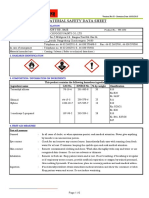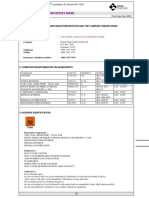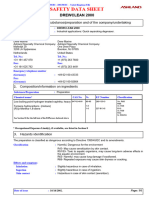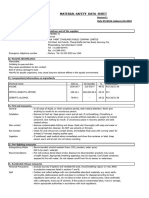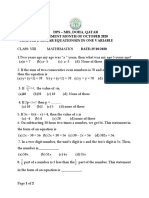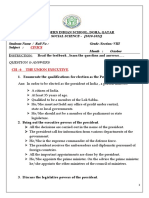Safety Data Sheet: Identification of The Substance/preparation and Company/undertaking 1
Safety Data Sheet: Identification of The Substance/preparation and Company/undertaking 1
Uploaded by
BCopyright:
Available Formats
Safety Data Sheet: Identification of The Substance/preparation and Company/undertaking 1
Safety Data Sheet: Identification of The Substance/preparation and Company/undertaking 1
Uploaded by
BOriginal Description:
Original Title
Copyright
Available Formats
Share this document
Did you find this document useful?
Is this content inappropriate?
Copyright:
Available Formats
Safety Data Sheet: Identification of The Substance/preparation and Company/undertaking 1
Safety Data Sheet: Identification of The Substance/preparation and Company/undertaking 1
Uploaded by
BCopyright:
Available Formats
This Safety Data Sheet is prepared in accordance with EU Directive 91/155/EC, as amended by Directive
2001/58/EC - Europe
SAFETY DATA SHEET
Jotafloor PU Topcoat - Comp. B
1. Identification of the substance/preparation and company/undertaking
Product name and/or code : Jotafloor PU Topcoat - Comp. B
Supplier/Manufacturer : Jotun UAE Ltd. (L.L.C.)
P.O.Box 3671, Dubai, U.A.E.
Tel: 009714 3395000
Fax:009714 3380666
Emergency telephone number : Jotun UAE Ltd. (L.L.C): +9714 3395000
Product use : Coatings: Solvent-borne.
2. Composition/information on ingredients
Chemical name* CAS no. EC number % Classification
hexane, 1,6-diisocyanato-, homopolymer 28182-81-2 500-060-2 50 - 100 R42/43
n-butyl acetate 123-86-4 204-658-1 2.5 - 10 R10
R66, R67
Solvent naphtha (petroleum), light arom. 64742-95-6 265-199-0 2.5 - 10 R10
Xn; R20, R65
Xi; R37
R66
N; R51/53
hexamethylene-di-isocyanate 822-06-0 212-485-8 0-1 T; R23
Xi; R36/37/38
R42/43
See section 16 for the full text of the R-phrases declared
above
Occupational exposure limits, if available, are listed in section 8.
3. Hazards identification
The preparation is classified as dangerous according to Directive 1999/45/EC and its amendments.
Flammable.
May cause sensitisation by inhalation and skin contact.
Harmful to aquatic organisms, may cause long-term adverse effects in
the aquatic environment.
Harmful
4. First-aid measures
First-aid measures
General : In all cases of doubt, or when symptoms persist, seek medical attention. Never give anything by
mouth to an unconscious person.
Inhalation : Remove to fresh air. Keep person warm and at rest. If not breathing, if breathing is irregular or if
respiratory arrest occurs, provide artificial respiration or oxygen by trained personnel. Give nothing by
mouth. If unconscious, place in recovery position and seek medical advice.
Skin contact : Remove contaminated clothing and shoes. Wash skin thoroughly with soap and water or use
recognised skin cleanser. Do not use solvents or thinners.
Eye contact : Check for and remove any contact lenses. Immediately flush eyes with running water for at least 15
minutes, keeping eyelids open.
Ingestion : If swallowed, seek medical advice immediately and show the container or label. Keep person warm
and at rest. Do not induce vomiting.
Date of issue : 27.02.2006. Page: 1/5
Jotafloor PU Topcoat - Comp. B
5. Fire-fighting measures
Extinguishing media : Recommended: alcohol-resistant foam, CO2, powders, water spray or mist.
Not to be used : water jet.
Recommendations : Fire will produce dense black smoke. Exposure to decomposition products may cause a health
hazard. Appropriate breathing apparatus may be required. Cool closed containers exposed to fire
with water. Do not release runoff from fire to sewers or waterways.
6. Accidental release measures
Personal precautions : Exclude sources of ignition and ventilate the area. Avoid breathing vapour or mist. Refer to
protective measures listed in sections 7 and 8.
Spill : Contain and collect spillage with non-combustible, absorbent material e.g. sand, earth, vermiculite or
diatomaceous earth and place in container for disposal according to local regulations (see section
13). Place in a suitable container. The contaminated area should be cleaned immediately with a
suitable decontaminant. One possible (flammable) decontaminant comprises (by volume): water (45
parts), ethanol or isopropyl alcohol (50 parts) and concentrated (d: 0,880) ammonia solution (5 parts)
. A non-flammable alternative is sodium carbonate (5 parts) and water (95 parts). Add the same
decontaminant to the remnants and let stand for several days until no further reaction in an unsealed
container. Once this stage is reached, close container and dispose of according to local regulations
(see section 13). Do not allow to enter drains or watercourses. If the product contaminates lakes,
rivers, or sewers, inform the appropriate authorities in accordance with local regulations.
Note: see section 8 for personal protective equipment and section 13 for waste disposal.
7. Handling and storage
Persons with a history of asthma, allergies or chronic or recurrent respiratory disease should not be employed in any process
in which this preparation is used.
Examination of lung function should be carried out on a regular basis on persons spraying this preparation.
Handling : Vapours are heavier than air and may spread along floors. Vapours may form explosive mixtures
with air. Prevent the creation of flammable or explosive concentrations of vapours in air and avoid
vapour concentrations higher than the occupational exposure limits.
In addition, the product should only be used in areas from which all naked lights and other sources of
ignition have been excluded. Electrical equipment should be protected to the appropriate standard.
To dissipate static electricity during transfer, earth drum and connect to receiving container with
bonding strap. Operators should wear antistatic footwear and clothing and floors should be of the
conducting type.
Keep container tightly closed. Precautions should be taken to minimise exposure to atmospheric
humidity or water. CO2 will be formed, which, in closed containers, could result in pressurisation.
Care should be taken when re-opening partly-used containers. Keep away from heat, sparks and
flame. No sparking tools should be used.
Avoid contact with skin and eyes. Avoid the inhalation of dust, particulates, spray or mist arising from
the application of this preparation. Avoid inhalation of dust from sanding.
Eating, drinking and smoking should be prohibited in area where this material is handled, stored and
processed. Workers should wash hands and face before eating, drinking and smoking.
Put on appropriate personal protective equipment (see section 8).
Never use pressure to empty. Container is not a pressure vessel. Always keep in containers made
from the same material as the original one.
Comply with the health and safety at work laws.
When operators, whether spraying or not, have to work inside the spray booth, ventilation is unlikely
to be sufficient to control particulates and solvent vapour in all cases. In such circumstances they
should wear a compressed air-fed respirator during the spraying process and until such time as the
particulates and solvent vapour concentration has fallen below the exposure limits.
Storage : Store in accordance with local regulations. Observe label precautions. Store in a cool, well-ventilated
area away from incompatible materials and ignition sources. Keep away from heat and direct
sunlight.
Keep away from: oxidising agents, strong alkalis, strong acids, amines, alcohols, water.
No smoking. Prevent unauthorised access. Containers that have been opened must be carefully
resealed and kept upright to prevent leakage.
Do not empty into drains..
Date of issue : 27.02.2006. Page: 2/5
Jotafloor PU Topcoat - Comp. B
8. Exposure controls/personal protection
Persons with a history of asthma, allergies or chronic or recurrent respiratory disease should not be employed in any process
in which this preparation is used.
Examination of lung function should be carried out on a regular basis on persons spraying this preparation.
Engineering measures : Provide adequate ventilation. Where reasonably practicable, this should be achieved by the use of
local exhaust ventilation and good general extraction. Air-fed protective respiratory equipment must
be worn by the spray operator, even when good ventilation is provided. In other operations, if local
exhaust ventilation and good general extraction are not sufficient to maintain concentrations of
particulates and solvent vapours below the OEL, suitable respiratory protection must be worn. (See
Personal protection.)
Ingredient name Occupational exposure limits
n-butyl acetate ACGIH TLV (United States, 1/2005). Notes: 1998 Adoption.
STEL: 200 ppm 15 minute/minutes. Form: All forms
TWA: 150 ppm 8 hour/hours. Form: All forms
Solvent naphtha (petroleum), light arom. EU OEL (Europe, 6/2000).
TWA: 100 mg/m3 8 hour/hours. Form: All forms
TWA: 20 ppm 8 hour/hours. Form: All forms
hexamethylene-di-isocyanate ACGIH TLV (United States, 1/2005).
TWA: 0,03 mg/m3 8 hour/hours. Form: All forms
TWA: 0,01 ppm 8 hour/hours. Form: All forms
Personal protective equipment
Respiratory system : Self-contained respiratory equipment must be worn by spray operator, even when good ventilation
is provided. By other operations than spraying, in well ventilated areas, air-fed respirators could be
replaced by a combination charcoal filter and particulate filter mask.
Skin and body : Personnel should wear antistatic clothing made of natural fibres or of high-temperature-resistant
synthetic fibres.
Hands : For prolonged or repeated handling, use gloves: polyvinyl alcohol or nitrile.
Barrier creams may help to protect the exposed areas of the skin but should not be applied once
exposure has occurred.
For right choice of glove materials, with focus on chemical resistance and time of penetration, seek
advice by the supplier of chemical resistant gloves.
Eyes : Use safety eyewear designed to protect against splash of liquids.
9. Physical and chemical properties
Physical state : Liquid.
Odour : Characteristic.
Colour : Various colours.
Flash point : Closed cup: 47°C (116.6°F).
Density : 1.1 g/cm3
Lower explosion limit : The greatest known range is Lower: 1.2% Upper: 7.5% (n-butyl acetate)
Solubility : Insoluble in cold water, hot water.
10. Stability and reactivity
Stable under recommended storage and handling conditions (see section 7).
Hazardous decomposition products: smoke, carbon monoxide, carbon dioxide, oxides of nitrogen, hydrogen cyanide.
Keep away from the following materials to prevent strong exothermic reactions: oxidising agents, strong alkalis, strong acids, amines,
alcohols, water.
Uncontrolled exothermic reactions occur with amines and alcohols.
The product reacts slowly with water, resulting in the production of carbon dioxide. In closed containers, pressure build-up could result
in distortion, expansion and, in extreme cases, bursting of the container.
11. Toxicological information
Based on the properties of the isocyanate components and considering toxicological data on similar preparations, this preparation
may cause acute irritation and/or sensitisation of the respiratory system, leading to an asthmatic condition, wheezing and tightness of
the chest. Sensitised persons may subsequently show asthmatic symptoms when exposed to atmospheric concentrations well below
the OEL. Repeated exposure may lead to permanent respiratory disability.
Exposure to component solvent vapour concentrations in excess of the stated occupational exposure limit may result in adverse
health effects such as mucous membrane and respiratory system irritation and adverse effects on the kidneys, liver and central
nervous system. Symptoms and signs include headache, dizziness, fatigue, muscular weakness, drowsiness and, in extreme cases,
Date of issue : 27.02.2006. Page: 3/5
Jotafloor PU Topcoat - Comp. B
loss of consciousness.
Repeated or prolonged contact with the preparation may cause removal of natural fat from the skin, resulting in non-allergic contact
dermatitis and absorption through the skin. Repeated or prolonged contact with irritants may cause dermatitis. If splashed in the eyes,
the liquid may cause irritation and reversible damage.
Contains (hexane, 1,6-diisocyanato-, homopolymer, Hexamethylene-di-isocyanate). May produce an allergic reaction.
12. Ecological information
There is no data available on the preparation itself.
Do not allow to enter drains or watercourses.
The preparation has been assessed following the conventional method of the Dangerous Preparations Directive 1999/45/EC and is
classified for eco-toxicological properties accordingly. See Sections 2 and 15 for details.
Ecotoxicity data
Ingredient name Species Period Result
n-butyl acetate Pimephales promelas (EC50) 48 hour/hours 19 mg/l
Pimephales promelas (LC50) 96 hour/hours 18 mg/l
Lepomis macrochirus (LC50) 96 hour/hours 100 mg/l
Solvent naphtha (petroleum), light arom. Fish (LC50) 96 hour/hours <10 mg/l
Daphnia (EC50) 48 hour/hours <10 mg/l
Algae (IC50) 72 hour/hours <10 mg/l
13. Disposal considerations
Do not allow to enter drains or watercourses. Material and/or container must be disposed of as hazardous waste.
European waste catalogue : 08 01 11* waste paint and varnish containing organic solvents or other dangerous substances
(EWC)
14. Transport information
International transport regulations
Proper shipping name : Paint.
UN Number : 1263
Class : 3
Sub-risk : -
Packing group : III
Label :
Additional information
ADR / RID : Hazard identification number: 30
Special provisions: 640E
ADR/RID: Viscous substance. Not restricted, ref. chapter 2.2.3.1.5 (applicable to receptacles < 450 litre
capacity).
IMDG : Emergency schedules (EmS): F-E, S-E
Marine pollutant: No.
IMDG: Viscous substance. Transport in accordance with paragraph 2.3.2.5 (applicable to receptacles < 30
litre capacity).
IATA : -
Transport in accordance with ADR/RID, IMDG/IMO and ICAO/IATA and national regulation.
-
15. Regulatory information
The product is labelled as follows, in accordance with local regulations:
EU regulations : The product is classified and labelled for supply in accordance with the Directive 1999/45/EC as
follows:
Date of issue : 27.02.2006. Page: 4/5
Jotafloor PU Topcoat - Comp. B
Hazard symbol/symbols :
Harmful
Contains : hexane, 1,6-diisocyanato-, homopolymer
Risk phrases : R10- Flammable.
R42/43- May cause sensitisation by inhalation and skin contact.
R52/53- Harmful to aquatic organisms, may cause long-term adverse effects in the aquatic
environment.
Safety phrases : S23- Do not breathe vapour / spray.
S24- Avoid contact with skin.
S37- Wear suitable gloves.
S45- In case of accident or if you feel unwell, seek medical advice immediately (show the label
where possible).
S51- Use only in well-ventilated areas.
Additional warning phrases : Contains isocyanates. See information supplied by the manufacturer. This information is provided
by the present Safety Data Sheet.
16. Other information
CEPE Classification : 5
Full text of R-phrases referred to : R10- Flammable.
in sections 2 and 3 - Europe R23- Toxic by inhalation.
R20- Harmful by inhalation.
R65- Harmful: may cause lung damage if swallowed.
R36/37/38- Irritating to eyes, respiratory system and skin.
R37- Irritating to respiratory system.
R42/43- May cause sensitisation by inhalation and skin contact.
R66- Repeated exposure may cause skin dryness or cracking.
R67- Vapours may cause drowsiness and dizziness.
R51/53- Toxic to aquatic organisms, may cause long-term adverse effects in the aquatic
environment.
R52/53- Harmful to aquatic organisms, may cause long-term adverse effects in the aquatic
environment.
Notice to reader
History
Date of printing : 27.02.2006.
Date of issue : 27.02.2006.
Version : 2
Prepared by : Jotun Group Product Safety Department
The information in this SDS is based on the present state of our knowledge and on current laws. The product is not to be used for purposes
other than those specified under section 1 without first obtaining written handling instructions. It is always the responsibility of the user to
take all necessary steps to fulfil the demands set out in the local rules and legislation. The information in this SDS is meant to be a description
of the safety requirements for our product. It is not to be considered a guarantee of the product's properties.
Indicates information that has changed from previously issued version.
Page: 5/5
Version 2
You might also like
- Download: Regulatory Compliance FundamentalsDocument3 pagesDownload: Regulatory Compliance FundamentalsZig ZigNo ratings yet
- SDS - Fenomastic Enamel Gloss - English (Uk) - Dubai PDFDocument5 pagesSDS - Fenomastic Enamel Gloss - English (Uk) - Dubai PDFB100% (1)
- Class 8 Ch-1 Indian Constitution PptsDocument19 pagesClass 8 Ch-1 Indian Constitution PptsB0% (2)
- SDS - Fenomastic Enamel Matt - English (Uk) - Dubai PDFDocument5 pagesSDS - Fenomastic Enamel Matt - English (Uk) - Dubai PDFBNo ratings yet
- MSDS AluflexDocument5 pagesMSDS Aluflexrian wijayaNo ratings yet
- Epicon T 500Document12 pagesEpicon T 500Mugilrajan DevarajanNo ratings yet
- MSDS BaltoflakeDocument5 pagesMSDS Baltoflakerian wijayaNo ratings yet
- MSDS 85675Document5 pagesMSDS 85675Taufiq AhamedNo ratings yet
- PCR 01. AlkydprimerDocument5 pagesPCR 01. AlkydprimerS Eshgin AlizadeNo ratings yet
- Hardtop Flexi Comp ADocument6 pagesHardtop Flexi Comp ANivin KumarNo ratings yet
- Sds-Evamarine ExteriorDocument6 pagesSds-Evamarine ExteriorSaifuddin FahmiNo ratings yet
- Material Safety Data Sheet: Product No.: 5512Document12 pagesMaterial Safety Data Sheet: Product No.: 5512didiNo ratings yet
- MSDS BarrierDocument6 pagesMSDS Barrierrian wijayaNo ratings yet
- Hempalin Enamel 52140Document5 pagesHempalin Enamel 52140Taufiq AhamedNo ratings yet
- k3 English PDFDocument6 pagesk3 English PDFDana PuteraNo ratings yet
- SDS - Fenomastic Emulsion Silk - English (Uk) - Dubai PDFDocument5 pagesSDS - Fenomastic Emulsion Silk - English (Uk) - Dubai PDFB50% (2)
- Material Safety Data Sheet: 1. Product and Company IdentificationDocument11 pagesMaterial Safety Data Sheet: 1. Product and Company IdentificationRenalyn TorioNo ratings yet
- Msds-Alkyd PrimerDocument5 pagesMsds-Alkyd Primerrian wijayaNo ratings yet
- Material Safety Data Sheet: Product No. 5400Document12 pagesMaterial Safety Data Sheet: Product No. 5400Taufiq damarNo ratings yet
- Curing AgentDocument5 pagesCuring Agentabdulgafoor54No ratings yet
- Umeguard SX White Cs-651Document12 pagesUmeguard SX White Cs-651Mugilrajan DevarajanNo ratings yet
- 3307 Sigma C200A Coal Tar EpoxyDocument3 pages3307 Sigma C200A Coal Tar Epoxyusman khalidNo ratings yet
- SDS - Fenomastic Emulsion Semigloss - English (Uk) - Dubai PDFDocument5 pagesSDS - Fenomastic Emulsion Semigloss - English (Uk) - Dubai PDFBNo ratings yet
- Safety Data Sheet: Identification of The Preparation and of The Company 1Document11 pagesSafety Data Sheet: Identification of The Preparation and of The Company 1Alex JosephNo ratings yet
- NORPOLR Gelcoat GD 11030 S EX3 (MSDS)Document5 pagesNORPOLR Gelcoat GD 11030 S EX3 (MSDS)Shahzaib KhanNo ratings yet
- 3307 SIGMA C200a COALTAR EPOXY BASEDocument8 pages3307 SIGMA C200a COALTAR EPOXY BASEMustafa hse JafferNo ratings yet
- 7658 Sigmacap Zinc Silicate Binder - MSDS KsaDocument7 pages7658 Sigmacap Zinc Silicate Binder - MSDS KsaEyoh EffiongNo ratings yet
- Alkali Resistant PrimerDocument5 pagesAlkali Resistant PrimereliNo ratings yet
- Taxat Extra ClassicDocument5 pagesTaxat Extra ClassicJHUPEL ABARIALNo ratings yet
- Hempel Hempadur MasticDocument5 pagesHempel Hempadur MasticJennylyn DañoNo ratings yet
- Safety Data Sheet: Identification of The Substance/preparation and Company/undertaking 1Document5 pagesSafety Data Sheet: Identification of The Substance/preparation and Company/undertaking 1Nivin KumarNo ratings yet
- MSDS SIGMAWELD 199 (SIGMAWELD MC) PASTE (ENG) (sk-17-03-07leg-MT)Document8 pagesMSDS SIGMAWELD 199 (SIGMAWELD MC) PASTE (ENG) (sk-17-03-07leg-MT)Eyoh EffiongNo ratings yet
- 5481 D9u7c5kubDocument5 pages5481 D9u7c5kubNandar Min HtetNo ratings yet
- X DULUX Solarscreen A339-Line ENDocument8 pagesX DULUX Solarscreen A339-Line ENAzuan MABKNo ratings yet
- Msds - Thinner CMP31 - Rev 1Document4 pagesMsds - Thinner CMP31 - Rev 1tiennv.blcmNo ratings yet
- SAFETY DATA SHEET - SML Marine PaintsDocument6 pagesSAFETY DATA SHEET - SML Marine PaintsNAMNo ratings yet
- MSDS Sikafloor264Document13 pagesMSDS Sikafloor264feroz khanNo ratings yet
- MSDS Amerlock 400 CureDocument5 pagesMSDS Amerlock 400 CureMohammad AseefNo ratings yet
- Traffic & Airfield 56880Document5 pagesTraffic & Airfield 56880Taufiq AhamedNo ratings yet
- Nippon Metal Primer Red Oxide MSDSDocument5 pagesNippon Metal Primer Red Oxide MSDSscarpredator5No ratings yet
- X DULUX Timbertone A398-Line ENDocument8 pagesX DULUX Timbertone A398-Line ENAzuan MABKNo ratings yet
- 0057 M4t2c5kubDocument6 pages0057 M4t2c5kubNandar Min HtetNo ratings yet
- SDS - Aluminium Paint H.R. - Marine - Protective - English (Uk) - SingaporeDocument6 pagesSDS - Aluminium Paint H.R. - Marine - Protective - English (Uk) - SingaporeAmi Terecef Gamboa MirandaNo ratings yet
- 4757 54a6c5kubDocument6 pages4757 54a6c5kubNandar Min HtetNo ratings yet
- 0016 K1fkc5kubDocument6 pages0016 K1fkc5kubNandar Min HtetNo ratings yet
- 0097 3s68c5kubDocument5 pages0097 3s68c5kubNandar Min HtetNo ratings yet
- Sikadur 31 MSDSDocument12 pagesSikadur 31 MSDSprueba gaaaaaNo ratings yet
- 0048 3tn5c5kubDocument6 pages0048 3tn5c5kubNandar Min HtetNo ratings yet
- 2014 - 05 - 01 Sds Us - Hyvolt IDocument8 pages2014 - 05 - 01 Sds Us - Hyvolt IDAYRON CARBONELLNo ratings yet
- 0063 6gtjc5kubDocument6 pages0063 6gtjc5kubNandar Min HtetNo ratings yet
- Material Safety Data Sheet: Sun Protectar 1. Product and Company IdentificationDocument6 pagesMaterial Safety Data Sheet: Sun Protectar 1. Product and Company IdentificationColin DaiNo ratings yet
- 4226 2p2mc5kubDocument6 pages4226 2p2mc5kubNandar Min HtetNo ratings yet
- SDS-SAC0307-QT459DE(Eng)Document8 pagesSDS-SAC0307-QT459DE(Eng)kavitaprasad0515No ratings yet
- SDS - Bengalac Red Oxide Primer - English (Uk) - DubaiDocument5 pagesSDS - Bengalac Red Oxide Primer - English (Uk) - DubaiBalasubramanian Ananth100% (1)
- Safety Data Sheet (SDS) : SHELL ALVANIA EP GREASE R000, R00, R0,1,2 Code:613131 Date:June 1, 2016 Page.1/5Document5 pagesSafety Data Sheet (SDS) : SHELL ALVANIA EP GREASE R000, R00, R0,1,2 Code:613131 Date:June 1, 2016 Page.1/5Nam ĐặngNo ratings yet
- Safety Data Sheet: Identification of The Preparation and of The Company 1Document5 pagesSafety Data Sheet: Identification of The Preparation and of The Company 1ducvuong99.vtNo ratings yet
- 6623 Cp4qc5kubDocument5 pages6623 Cp4qc5kubNandar Min HtetNo ratings yet
- MSDS 731Document7 pagesMSDS 731GautamNo ratings yet
- Clearedge Ep 284-2002Document4 pagesClearedge Ep 284-2002wadi ajanaNo ratings yet
- After a Disaster - Information to Help You and Your Family RecoverFrom EverandAfter a Disaster - Information to Help You and Your Family RecoverNo ratings yet
- Optigal’s Q & A for the CLRE: Contact Lens Registry Exam Questions Basic Certification - NCLEFrom EverandOptigal’s Q & A for the CLRE: Contact Lens Registry Exam Questions Basic Certification - NCLENo ratings yet
- 2022 MAY AssignmentDocument5 pages2022 MAY AssignmentBNo ratings yet
- Chapter 4 Agriculture 22Document5 pagesChapter 4 Agriculture 22BNo ratings yet
- Dps - Modern Indian School - Doha, Qatar Worksheet - 1 For The First Week of Remote Learning APRIL (2020 - 21) Grade V-MathematicsDocument4 pagesDps - Modern Indian School - Doha, Qatar Worksheet - 1 For The First Week of Remote Learning APRIL (2020 - 21) Grade V-MathematicsBNo ratings yet
- Notes - Godfrey Gordon Gustavus GoreDocument2 pagesNotes - Godfrey Gordon Gustavus GoreB100% (1)
- Binder1 MathsDocument24 pagesBinder1 MathsBNo ratings yet
- Bpoint - Revolt - of 1857Document3 pagesBpoint - Revolt - of 1857BNo ratings yet
- Bpnts-CH3 Fundamental Rights & Duties..Cls8Document5 pagesBpnts-CH3 Fundamental Rights & Duties..Cls8BNo ratings yet
- 8th Civics Indian Const Assignment 2020Document2 pages8th Civics Indian Const Assignment 2020BNo ratings yet
- Class 8th Notes Civics Chap 1Document3 pagesClass 8th Notes Civics Chap 1B100% (1)
- THE DREAM CATCHER NotesDocument3 pagesTHE DREAM CATCHER NotesB0% (1)
- Class VIII Computer Science Week 1 PPT-converted 2020Document19 pagesClass VIII Computer Science Week 1 PPT-converted 2020BNo ratings yet
- Class 8 First Term Cs Assignment (20-21)Document2 pagesClass 8 First Term Cs Assignment (20-21)BNo ratings yet
- Grade 5 April ASSIGNMENT - 2020-21Document6 pagesGrade 5 April ASSIGNMENT - 2020-21BNo ratings yet
- Class VIII Computer Science Weekly Lesson PlanDocument1 pageClass VIII Computer Science Weekly Lesson PlanB0% (1)
- LS 6 - TYPES OF AGRICULTURE (Part 3)Document13 pagesLS 6 - TYPES OF AGRICULTURE (Part 3)BNo ratings yet
- Maths October Month Assignment Linear Equations in One VariableDocument2 pagesMaths October Month Assignment Linear Equations in One VariableBNo ratings yet
- Questions & Answers: NstructionsDocument3 pagesQuestions & Answers: NstructionsBNo ratings yet
- Class 8 Computer Science Compiled Weekly AssignmentsDocument8 pagesClass 8 Computer Science Compiled Weekly AssignmentsBNo ratings yet
- Reproduction in Animals CLASS VIII NOTESDocument7 pagesReproduction in Animals CLASS VIII NOTESBNo ratings yet
- October Monthly AssignmentDocument1 pageOctober Monthly AssignmentBNo ratings yet
- Class VIII Chapter 2 Notes ComputerDocument4 pagesClass VIII Chapter 2 Notes ComputerBNo ratings yet
- Contribution To Webzine 2020 - 21 (Second Edition) : Literary Corner: Quarantine Edition Grade VIII - XIIDocument1 pageContribution To Webzine 2020 - 21 (Second Edition) : Literary Corner: Quarantine Edition Grade VIII - XIIBNo ratings yet
- October Assignment Class 8 PhysicsDocument2 pagesOctober Assignment Class 8 PhysicsBNo ratings yet
- The Union Executive Notes CivicsDocument3 pagesThe Union Executive Notes CivicsBNo ratings yet
- Dps Modern Indian School, Doha, Qatar: Part-ADocument2 pagesDps Modern Indian School, Doha, Qatar: Part-ABNo ratings yet
- Hempalin Primer HI-Bauild 13200 1320022430 En-UsDocument18 pagesHempalin Primer HI-Bauild 13200 1320022430 En-UsBNo ratings yet
- Letter To The Editor-SampleDocument3 pagesLetter To The Editor-SampleB100% (1)
- Product DataDocument2 pagesProduct DataBNo ratings yet
- Assignment Oct-Class - 5Document4 pagesAssignment Oct-Class - 5BNo ratings yet
- Ufgs 32 16 15Document11 pagesUfgs 32 16 15Sigit BintanNo ratings yet
- Australian/New Zealand StandardDocument8 pagesAustralian/New Zealand Standardapmco1389No ratings yet
- Sankalp Monthly Test Notice (Class 11)Document1 pageSankalp Monthly Test Notice (Class 11)navansh bansalNo ratings yet
- Endocrine SystemDocument29 pagesEndocrine SystemNiño Adan CadagNo ratings yet
- Literature Review Hepatitis BDocument7 pagesLiterature Review Hepatitis Bgw259gj7100% (1)
- Small Animal Abdominal Ultrasonography, Part 2 - Physical Principles of Artifacts and False Assumptions - Today's Veterinary PracticeDocument15 pagesSmall Animal Abdominal Ultrasonography, Part 2 - Physical Principles of Artifacts and False Assumptions - Today's Veterinary PracticeDalia ExtrapolisNo ratings yet
- Assignment 1 - Financial Statement AnalysisDocument2 pagesAssignment 1 - Financial Statement AnalysisNabilla RahmadhiyaNo ratings yet
- CMO 09 s2008 - Annex III BSME Course Specification PDFDocument68 pagesCMO 09 s2008 - Annex III BSME Course Specification PDFcresjohn100% (1)
- CAM2023 ZahraDorostkarDocument17 pagesCAM2023 ZahraDorostkarMarco VillacisNo ratings yet
- Narcan RevisedDocument2 pagesNarcan RevisedAmy PachlaNo ratings yet
- PAgibigDocument2 pagesPAgibigMark DacascusNo ratings yet
- DMS®Document26 pagesDMS®Neha BhuptaniNo ratings yet
- RISK ASSESSMENT - Blockwork and Concrete BreakingDocument11 pagesRISK ASSESSMENT - Blockwork and Concrete BreakingShaffi MohammedNo ratings yet
- May2012 - Renovating and Revamping Your Home PDFDocument45 pagesMay2012 - Renovating and Revamping Your Home PDFKapil RampalNo ratings yet
- 2023 Budget Planner Printable PagesDocument8 pages2023 Budget Planner Printable PagesAzalea ChayNo ratings yet
- (For Quotation) 138818 - The Waves ClubDocument1 page(For Quotation) 138818 - The Waves ClubGie UngonNo ratings yet
- ANP1106B Syllabus 2020 ModifiedDocument5 pagesANP1106B Syllabus 2020 ModifiedphilofaltasNo ratings yet
- Nuclear Hazard: Environmental StudiesDocument6 pagesNuclear Hazard: Environmental StudiesayushNo ratings yet
- Social Learning: by MadhaviDocument12 pagesSocial Learning: by MadhaviRachamalla KrishnareddyNo ratings yet
- Penerangan Ringkas Berkaitan Dengan Projek Yang Dipilih - Rujuk Buku TeksDocument3 pagesPenerangan Ringkas Berkaitan Dengan Projek Yang Dipilih - Rujuk Buku TeksArief IzzuddinNo ratings yet
- Free Questions For By: CAD ActualtestdumpsDocument19 pagesFree Questions For By: CAD Actualtestdumpskpkayum11No ratings yet
- Domino Editor GT Operator'S Reference GuideDocument42 pagesDomino Editor GT Operator'S Reference Guidejuan luis Torres100% (1)
- Solving Percent Problems Learning Objective(s)Document8 pagesSolving Percent Problems Learning Objective(s)VincentAlejandroNo ratings yet
- A Journey On A Ship For PleasureDocument4 pagesA Journey On A Ship For PleasurePhan ThưNo ratings yet
- Coins Collection 25 CentsDocument10 pagesCoins Collection 25 CentsScribdTranslationsNo ratings yet
- Social Media Use and Academic Performance of StudentsDocument44 pagesSocial Media Use and Academic Performance of StudentsmargaretteolbesNo ratings yet
- Raja Electricals Consortium Brief Note 08 10 2021Document3 pagesRaja Electricals Consortium Brief Note 08 10 2021MSME SULABH TUMAKURUNo ratings yet
- Create and Manage Elastic Pools in Azure SQL DatabaseDocument4 pagesCreate and Manage Elastic Pools in Azure SQL DatabaseSorinNo ratings yet
- Firefly Magazine Issue 8 FinalDocument180 pagesFirefly Magazine Issue 8 Finalapi-324155285No ratings yet
















